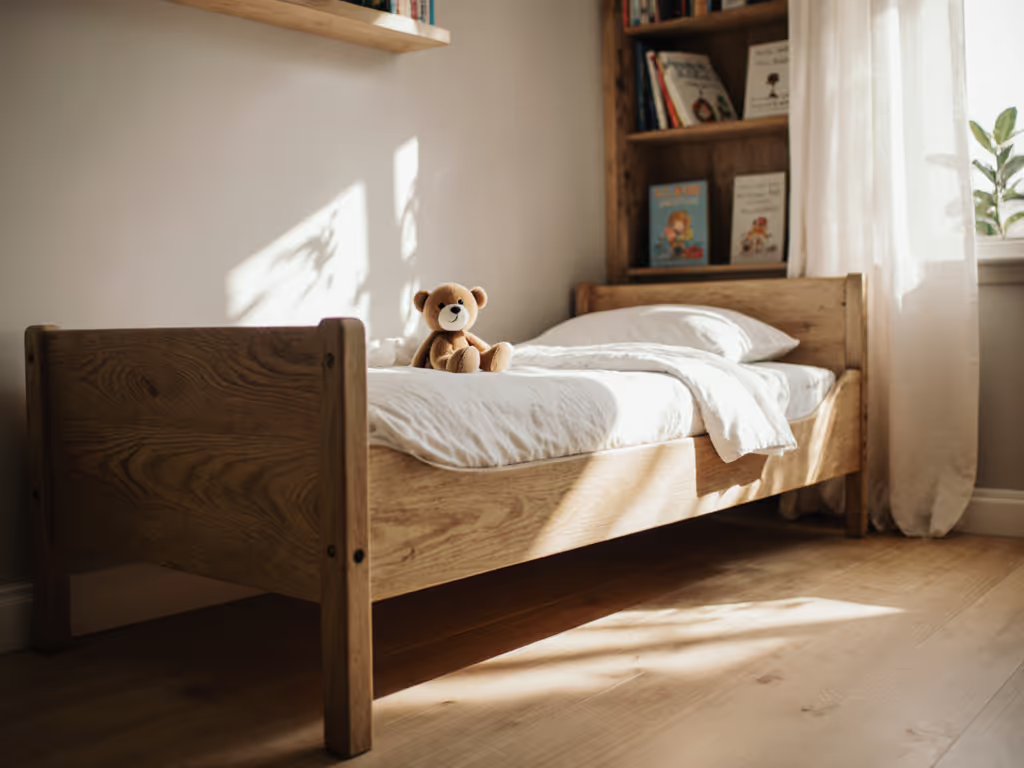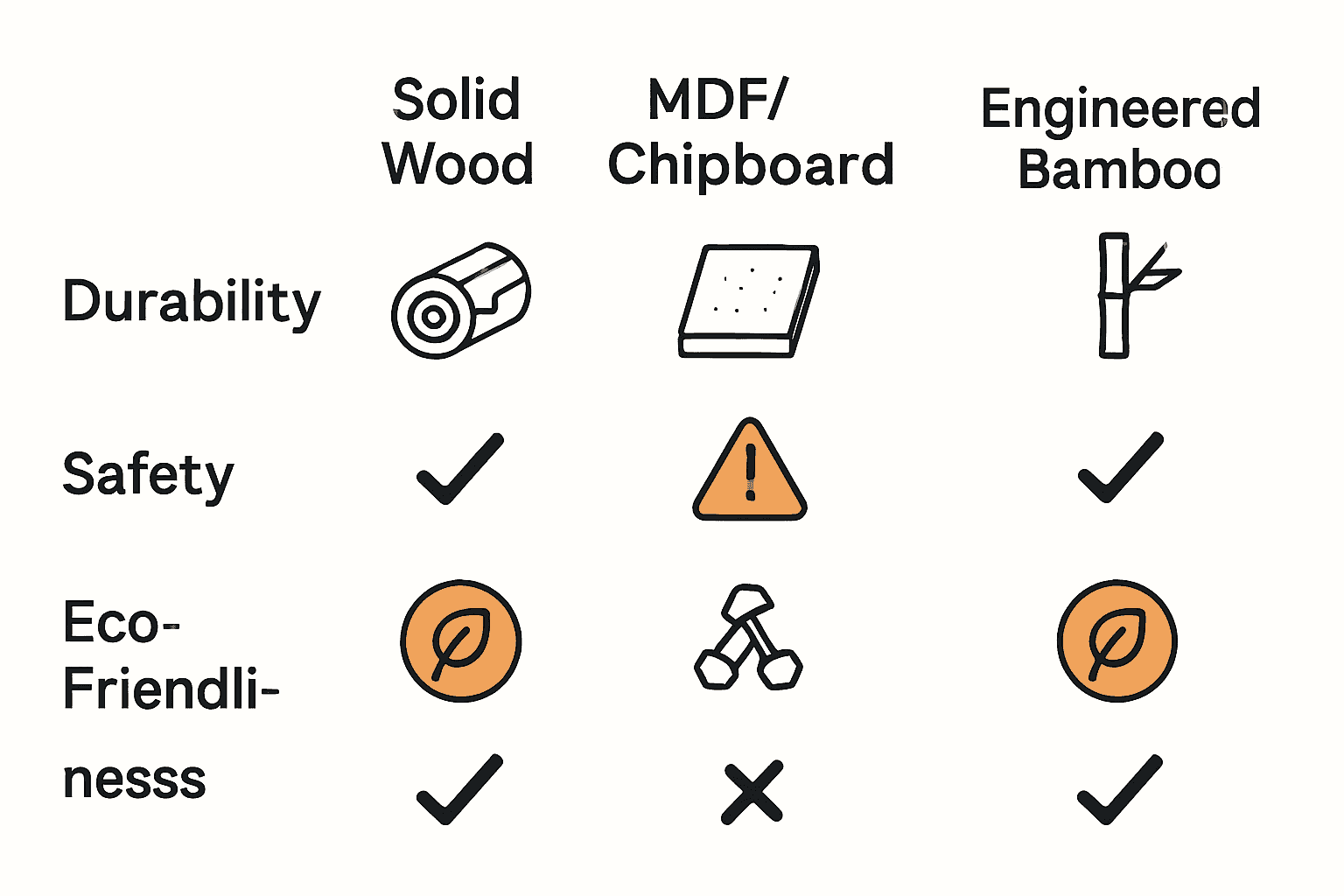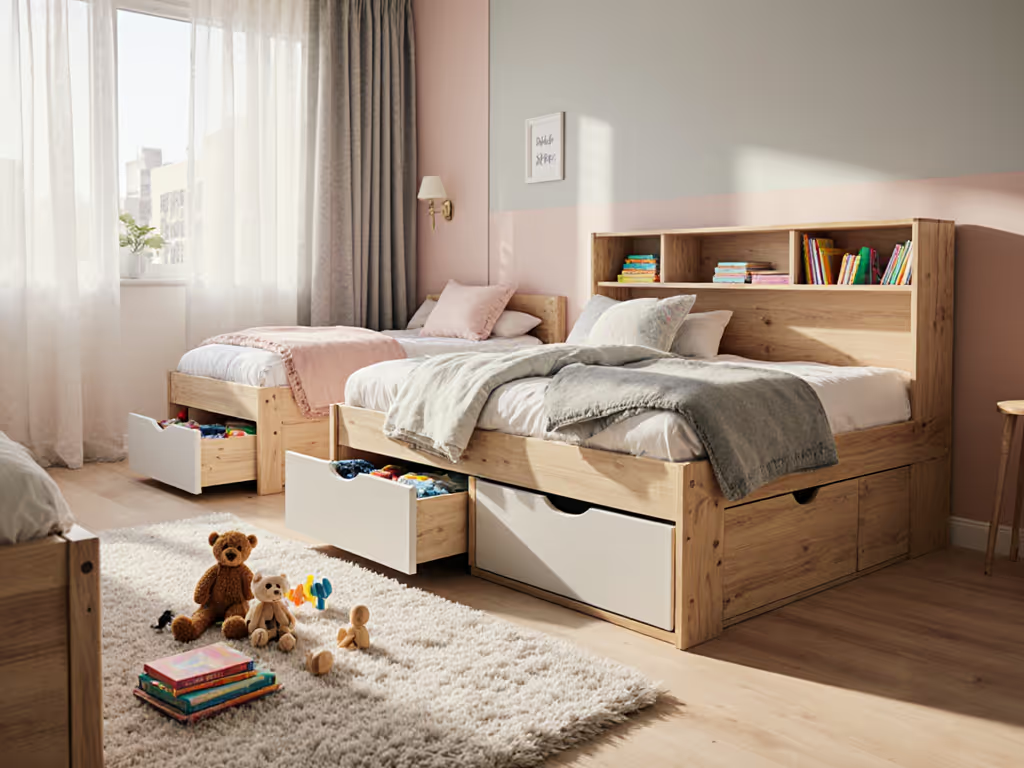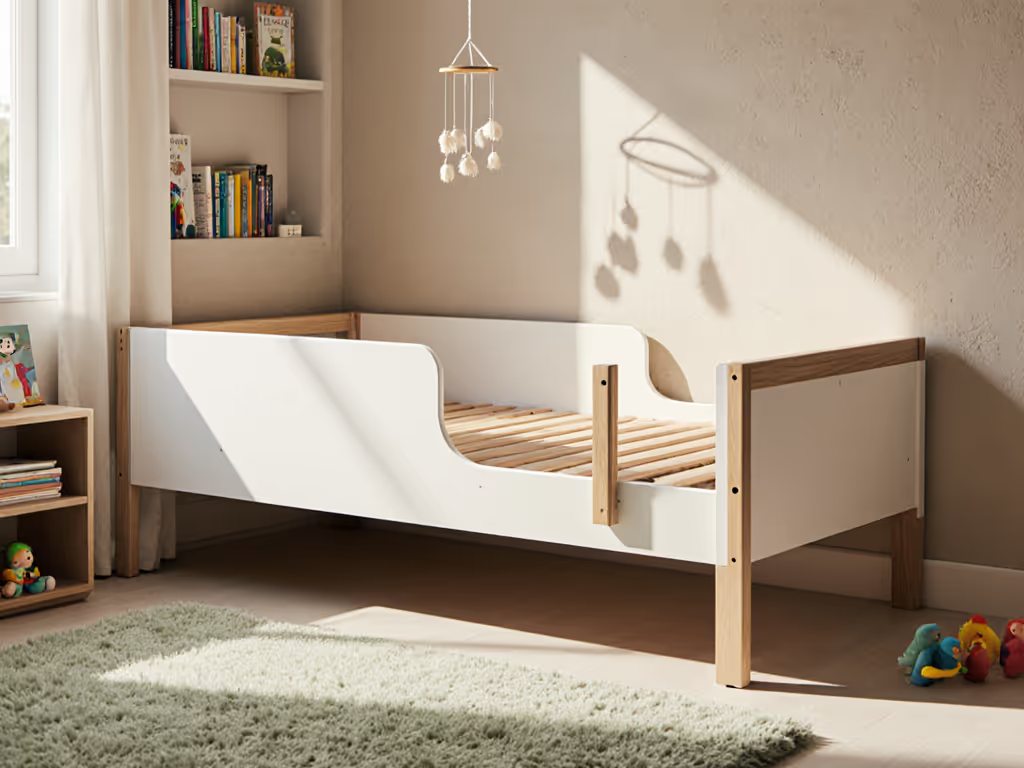
Why Solid Wood Beds: Complete Guide for Parents

More than 60 percent of parents prefer solid wood beds for their toddlers because they value safety and long-term durability over cheaper alternatives. A child's bed does more than provide a place to sleep—it shapes nightly routines and supports healthy growth. Understanding what truly makes a solid wood bed special helps families invest confidently in furniture that stands up to everyday toddler life while keeping the bedroom both safe and stylish.
Key Takeaways
| Point | Details |
|---|---|
| Durability and Safety | Solid wood beds provide superior structural integrity and resistance to wear, essential for active toddlers. |
| Sustainability | Choosing solid wood beds supports eco-friendly practices with natural materials that emit fewer harmful chemicals. |
| Long-term Value | Despite higher initial costs, solid wood beds offer longevity and customization, making them a wise investment. |
| Health Advantages | Solid wood beds minimize exposure to toxic chemicals, promoting a healthier sleep environment for children. |
Defining Solid Wood Beds for Toddlers
When you're looking to create a safe and nurturing sleep environment for your little one, solid wood beds represent more than just a piece of furniture. They're an investment in your child's comfort, growth, and overall bedroom ecosystem. Unlike mass-produced alternatives, solid wood beds bring a unique combination of durability, safety, and natural aesthetic that can transform a toddler's sleeping space.
A solid wood bed isn't just about the material—it's about creating a sustainable, adaptable sleeping solution that grows with your child. Research from bioresources highlights the potential for modular design in children's beds, suggesting that well-crafted wooden beds can be engineered with adjustable components to accommodate different growth stages. This means you're not just buying a bed, but investing in a long-term sleeping solution that can potentially adapt from toddlerhood through early childhood.

The key characteristics that define a solid wood bed for toddlers include:
- Natural material construction: Made entirely from genuine wood without composite or particle board fillers
- Robust structural integrity: Capable of withstanding active child play and movement
- Smooth, rounded edges: Minimizing potential injury risks
- Potential for customization: Can be refinished or adjusted as your child grows
From a practical perspective, solid wood beds offer parents more than aesthetic appeal. They provide superior durability compared to cheaper alternatives. According to reinforced bed research, wooden bed frames demonstrate exceptional long-term performance when properly maintained. The natural resilience of wood means these beds can endure years of jumping, climbing, and occasional rough handling—traits synonymous with toddler behavior.
Plus, wood's inherent properties allow for easier repair and refinishing, extending the bed's functional lifespan far beyond synthetic materials.
Types of Solid Wood Used in Beds
Choosing the right wood for a toddler's bed is more than a design decision—it's about selecting a material that balances safety, durability, and long-term performance. Hardwoods and softwoods each bring unique characteristics to children's furniture, with some materials standing out as particularly suitable for creating a reliable sleeping environment.
Traditional woodworking resources highlight several premium wood types that excel in bed construction. Oak, renowned for its incredible strength and resistance to wear, tops the list for parents seeking a robust bed frame. Maple follows closely, offering a dense, tight-grained structure that withstands significant impact. Softwoods like pine provide a more budget-friendly alternative, though they require more careful maintenance to ensure longevity.
Here's a comparative breakdown of wood types commonly used in toddler beds:
- Oak: Extremely durable, resistant to scratches, higher price point
- Maple: Dense and strong, smooth finish, moderate cost
- Pine: Lightweight, affordable, more prone to dents and scratches
- Cherry: Beautiful grain, moderate durability, warm color tones
- Walnut: Rich color, exceptional strength, premium pricing
Traditional Chinese furniture crafting techniques offer fascinating insights into wood selection. Materials like rosewood and huali wood demonstrate how density and aesthetic appeal can coexist in furniture design. These woods aren't just about looks—they represent centuries of understanding how different wood characteristics impact furniture performance. For toddler beds, this translates to choosing wood that can handle energetic play, occasional bumps, and the inevitable wear of childhood while maintaining structural integrity and safety.
Key Benefits: Safety, Durability, Longevity
Parents investing in a solid wood bed aren't just purchasing furniture—they're creating a foundational sleep environment that protects and supports their child's growth. Safety stands at the forefront of this investment, with solid wood beds offering inherent structural advantages that mass-produced alternatives simply cannot match. Unlike beds made from composite materials or thin metal frames, wooden beds provide a robust, stable platform that can withstand the energetic movements of curious toddlers.
Research from bioresources underscores the critical design elements that make solid wood beds exceptional. Modular construction allows these beds to adapt to a child's changing needs, potentially extending their useful life through multiple growth stages. This adaptability means parents can adjust bed configurations, add safety rails, or modify dimensions without compromising the bed's core structural integrity. The natural density of wood creates intrinsic safety features—smooth edges, resistance to splintering, and the ability to absorb impact make these beds far more reliable than cheaper alternatives.
The key safety and durability benefits of solid wood beds include:
- Structural Integrity: Capable of supporting dynamic child movement
- Impact Resistance: Minimal risk of frame collapse or sudden failure
- Smooth Surface: Reduced risk of sharp edges or dangerous protrusions
- Natural Material: No toxic chemical off-gassing common in synthetic materials
- Repairability: Easy to sand, refinish, or repair minor damages
Longevity represents another compelling advantage of solid wood beds. While initial costs might be higher, these beds offer remarkable long-term value. Research from reinforced bed studies reveals that well-maintained wooden bed frames can easily transition from toddlerhood through early childhood and potentially even be passed down to younger siblings. The natural durability of woods like oak, maple, and walnut means these beds can endure years of active use, representing a smart investment in both your child's comfort and your household's long-term furnishing strategy.
Eco-Friendly and Health Advantages Explained
Choosing a solid wood bed goes far beyond aesthetic appeal—it's a conscious decision that impacts both your child's immediate health and the broader environmental ecosystem. Natural wood materials offer remarkable advantages that synthetic alternatives simply cannot match, creating a sleeping environment that supports both personal wellness and planetary sustainability.
The health benefits of solid wood beds stem from their inherent natural properties. Organic materials like sustainably harvested hardwoods naturally regulate humidity, resist bacterial growth, and emit minimal volatile organic compounds (VOCs). Unlike mass-produced beds constructed from particle board or synthetic materials that can off-gas harmful chemicals, solid wood beds provide a clean, breathable sleeping surface. This is especially crucial for toddlers, whose developing respiratory systems and sensitive skin require the purest possible environmental conditions.
Key eco-friendly and health advantages include:
- Low Chemical Exposure: Minimal synthetic treatments or harmful adhesives
- Natural Humidity Regulation: Wood's inherent ability to absorb and release moisture
- Hypoallergenic Properties: Resistance to dust mites and microbial growth
- Sustainable Sourcing: Options from responsibly managed forest resources
- Biodegradable End-of-Life: Unlike plastic or metal alternatives
Engineered alternatives like bamboo are emerging as innovative eco-friendly options, demonstrating the furniture industry's commitment to sustainable practices. These materials offer rapid renewability and lower environmental impact compared to traditional wood harvesting. By selecting a solid wood bed, parents aren't just investing in furniture—they're making a statement about environmental responsibility, supporting responsible manufacturing practices, and creating a healthier sleep environment that nurtures their child's physical and developmental well-being.
Solid Wood Beds vs. Other Bed Materials
When it comes to selecting the perfect bed for your toddler, understanding the fundamental differences between solid wood and alternative materials can be a game-changer. Each material brings its own set of characteristics, strengths, and potential drawbacks that directly impact your child's sleeping environment, safety, and overall bedroom experience.
Research from materials science reveals significant distinctions between solid wood and manufactured alternatives like Medium Density Fiberboard (MDF), chipboard, and plywood. Engineered materials might seem cost-effective initially, but they often compromise on critical factors such as structural integrity, longevity, and potential health implications. MDF and chipboard, for instance, are composed of compressed wood particles and adhesives that can release harmful volatile organic compounds (VOCs), potentially affecting indoor air quality and your child's respiratory health.
Here's a comparative breakdown of bed materials:
- Solid Wood: - Highest durability
- Natural material
- Low chemical exposure
- Repairable and refinishable
- MDF/Chipboard:
- Lower cost
- Less structural integrity
- Higher chemical off-gassing
- Prone to moisture damage
- Metal Frames:
- Lightweight
- Cold surface
- Potential for sharp edges
- Limited customization
- Engineered Bamboo:
- Rapidly renewable
- Moderate durability
- Sustainable production
- Less traditional aesthetic
Emergent materials like engineered bamboo present interesting alternatives, offering sustainability and moderate performance.
 However, solid wood remains unparalleled in providing a comprehensive solution that balances safety, durability, health considerations, and aesthetic appeal. The initial higher investment in a solid wood bed translates to long-term benefits—a bed that can grow with your child, withstand years of use, and potentially become a cherished family heirloom.
However, solid wood remains unparalleled in providing a comprehensive solution that balances safety, durability, health considerations, and aesthetic appeal. The initial higher investment in a solid wood bed translates to long-term benefits—a bed that can grow with your child, withstand years of use, and potentially become a cherished family heirloom.
Cost, Maintenance, and Common Pitfalls
Investing in a solid wood bed is more complex than simply comparing price tags. Parents must navigate a nuanced landscape of upfront costs, long-term maintenance, and potential hidden expenses that can significantly impact their overall investment. Understanding these financial and practical considerations is crucial for making an informed decision that balances immediate affordability with lasting value.
Cost analysis from manufacturing research reveals that while solid wood beds typically have a higher initial price point, their long-term economic benefits often outweigh cheaper alternatives. Lifecycle costing demonstrates that beds made from high-quality wood can last significantly longer than manufactured materials like MDF or chipboard, effectively reducing replacement expenses. The ability to sand, refinish, and repair solid wood beds means parents can extend the furniture's useful life, transforming a seemingly expensive purchase into a remarkably cost-effective solution.
Common maintenance challenges and potential pitfalls include:
- Scratch Vulnerability: Natural wood requires careful handling
- Weight Considerations: Heavier frames can be difficult to move
- Seasonal Wood Movement: Potential for slight dimensional changes
- Finish Maintenance: Periodic re-oiling or waxing might be necessary
- Temperature Sensitivity: Wood can expand or contract with humidity changes
Professional bed manufacturing studies highlight that while solid wood beds demand more attentive maintenance, they offer unparalleled customization and repair potential. Unlike disposable furniture that ends up in landfills, a well-maintained wooden bed can be sanded, restained, or even partially reconstructed. This adaptability means parents aren't just buying a bed—they're investing in a piece of furniture that can potentially accompany a child from toddlerhood through early adolescence, making the initial higher cost a strategic long-term investment in quality and sustainability.
Discover the Perfect Solid Wood Bed for Your Toddler Today
Choosing the right bed for your toddler is one of the most important decisions you will make as a parent. The challenges of finding a durable, safe, and eco-friendly solid wood bed that truly grows with your child can feel overwhelming. You want a bed that withstands lively play, supports your child's comfort, and protects their health without compromising style or space.
At City Toddler Beds, we understand these concerns deeply. Our expert guides focus on everything from natural material construction to safety features like smooth edges and modular designs that adapt as your child grows. Don't settle for less when it comes to your child’s sleep environment. Explore our comprehensive resources that help you compare types of wood, understand maintenance needs, and recognize the long-term benefits of solid wood beds.
Ready to make a confident choice that safeguards your child’s well-being and offers lasting value? Start your journey with our detailed insights at City Toddler Beds. Visit now and give your toddler the gift of a safe and sturdy bed crafted to keep up with their adventures for years to come.
Frequently Asked Questions
What are the key benefits of solid wood beds for toddlers?
Solid wood beds provide exceptional durability, safety features, and long-term value. Their robust construction can withstand active toddler behavior, while smooth edges minimize injury risks. Additionally, they are easy to repair and can last through multiple growth stages.
How do solid wood beds compare to beds made from engineered materials?
Solid wood beds offer superior structural integrity and lower chemical exposure compared to engineered materials like MDF or chipboard, which can off-gas harmful VOCs. Solid wood is also more durable and can be refinished, making it a better long-term investment.
What types of wood are best for toddler beds?
Hardwoods such as oak and maple are excellent choices due to their strength and durability. Softwoods, like pine, are lighter and more affordable but may require more maintenance. It's important to choose wood that can handle the wear and tear of toddler activities.
Are solid wood beds eco-friendly?
Yes, solid wood beds can be eco-friendly, especially when made from sustainably sourced wood. They emit minimal VOCs and are biodegradable, unlike many synthetic alternatives. Choosing solid wood helps create a healthier sleep environment for your child.




